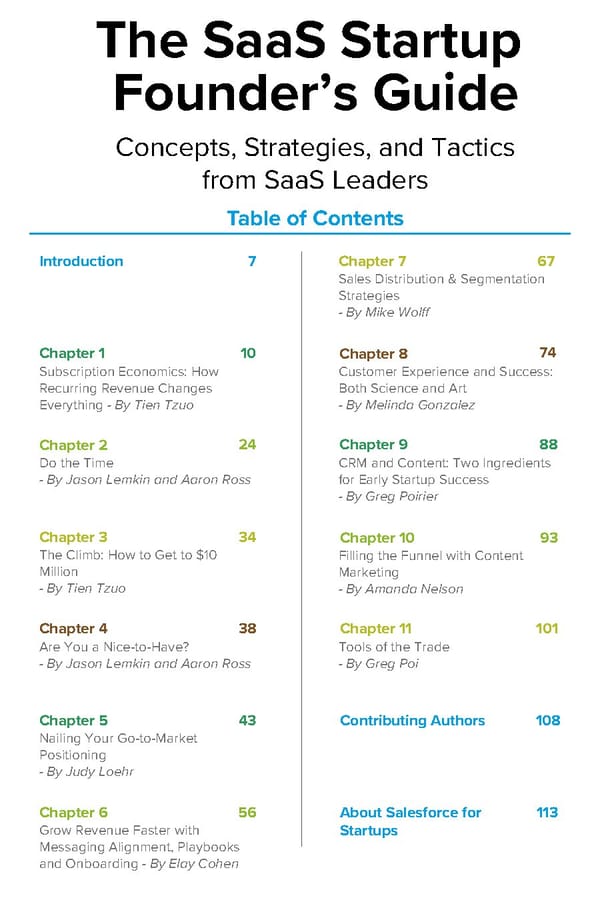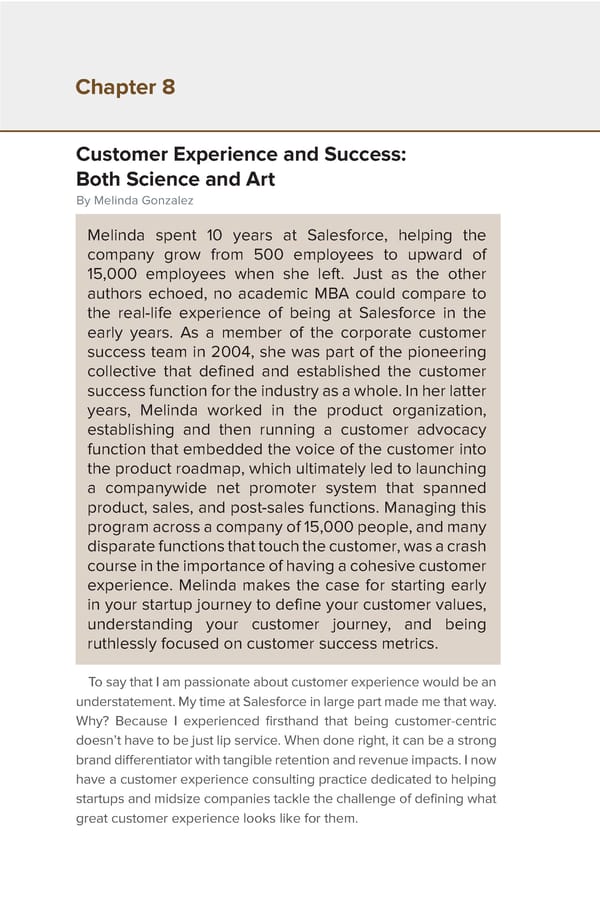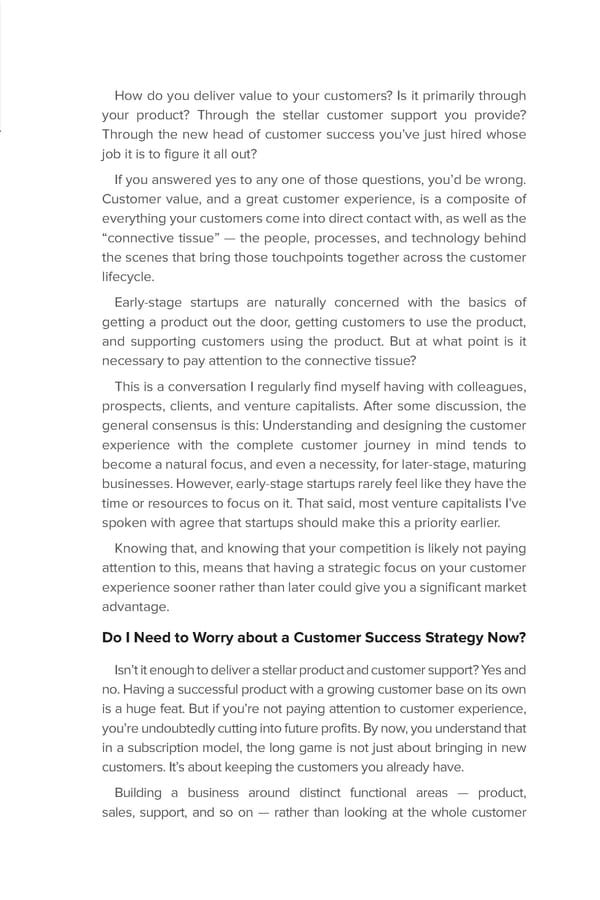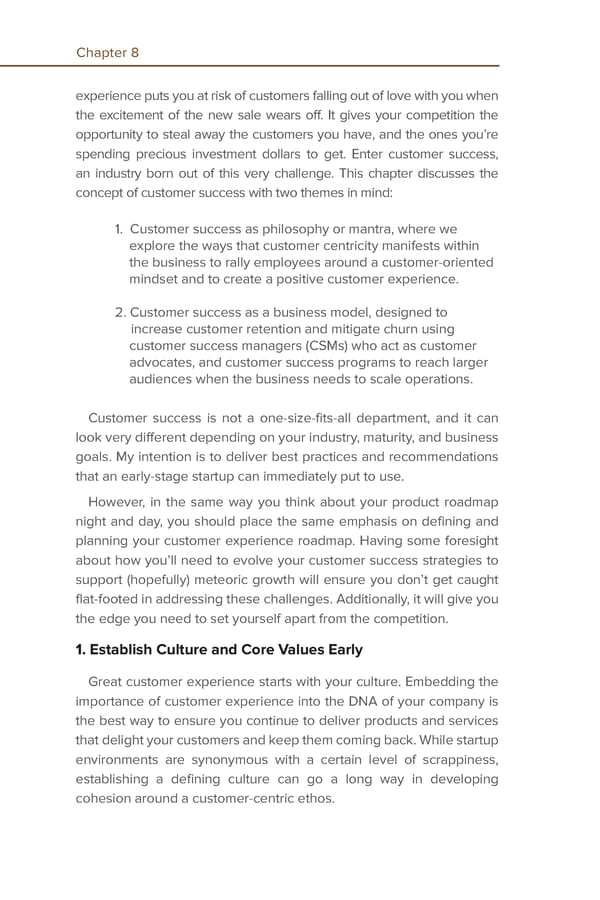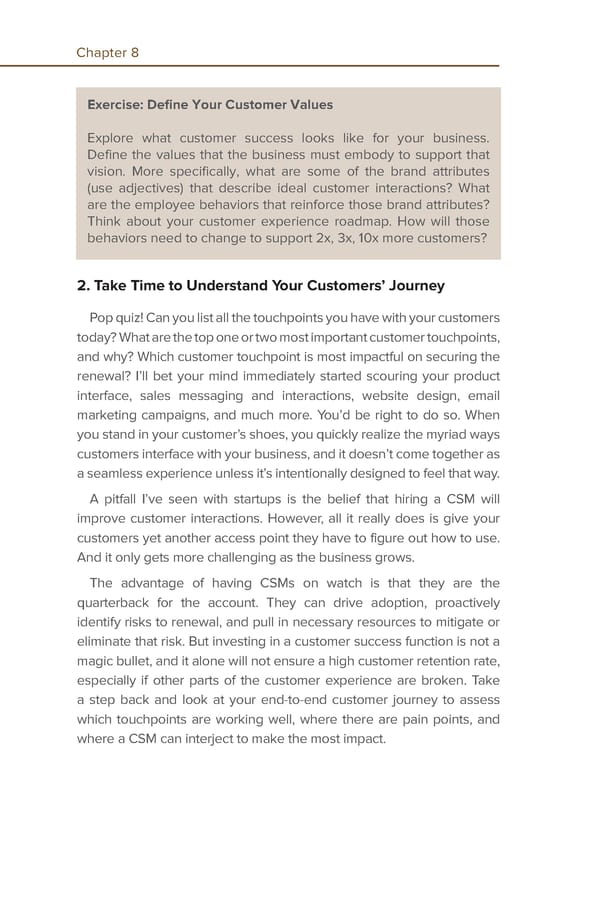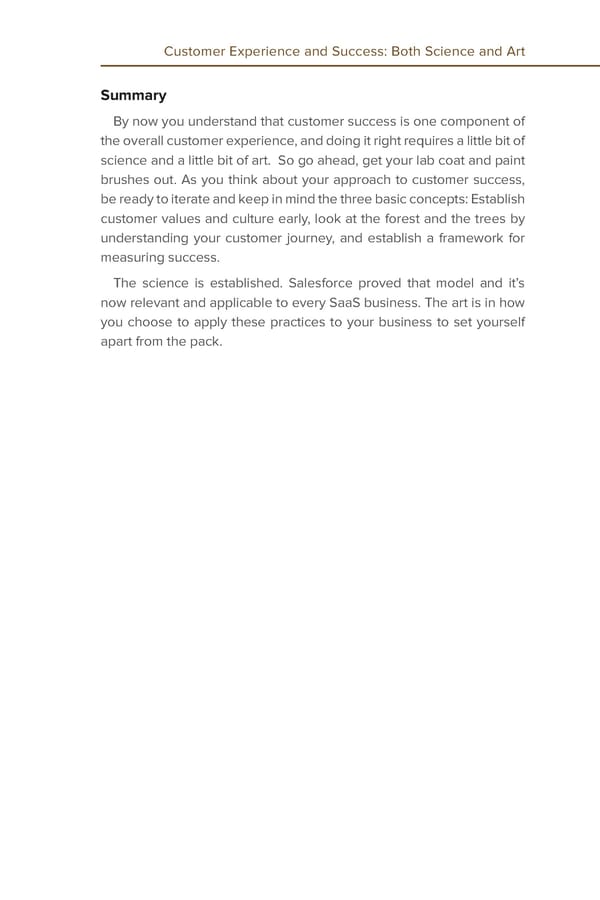Customer Experience and Success
By Melinda Gonzalez, GVP Customer Success, WeWork
The SaaS Startup Founder’s Guide Concepts, Strategies, and Tactics from SaaS Leaders Table of Contents Introduction 7 Chapter 7 67 Sales Distribution & Segmentation Strategies - By Mike Wolff Chapter 1 10 Chapter 8 74 Subscription Economics: How Customer Experience and Success: Recurring Revenue Changes Both Science and Art Everything - By Tien Tzuo - By Melinda Gonzalez Chapter 2 24 Chapter 9 88 Do the Time CRM and Content: Two Ingredients - By Jason Lemkin and Aaron Ross for Early Startup Success - By Greg Poirier Chapter 3 34 Chapter 10 93 The Climb: How to Get to $10 Filling the Funnel with Content Million Marketing - By Tien Tzuo - By Amanda Nelson Chapter 4 38 Chapter 11 101 Are You a Nice-to-Have? Tools of the Trade - By Jason Lemkin and Aaron Ross - By Greg Poi Chapter 5 43 Contributing Authors 108 Nailing Your Go-to-Market Positioning - By Judy Loehr Chapter 6 56 About Salesforce for 113 Grow Revenue Faster with Startups Messaging Alignment, Playbooks and Onboarding - By Elay Cohen
Chapter 8 Customer Experience and Success: Both Science and Art By Melinda Gonzalez Melinda spent 10 years at Salesforce, helping the company grow from 500 employees to upward of 15,000 employees when she left. Just as the other authors echoed, no academic MBA could compare to the real-life experience of being at Salesforce in the early years. As a member of the corporate customer success team in 2004, she was part of the pioneering collective that defined and established the customer success function for the industry as a whole. In her latter years, Melinda worked in the product organization, establishing and then running a customer advocacy function that embedded the voice of the customer into the product roadmap, which ultimately led to launching a companywide net promoter system that spanned product, sales, and post-sales functions. Managing this program across a company of 15,000 people, and many disparate functions that touch the customer, was a crash course in the importance of having a cohesive customer experience. Melinda makes the case for starting early in your startup journey to define your customer values, understanding your customer journey, and being ruthlessly focused on customer success metrics. To say that I am passionate about customer experience would be an understatement. My time at Salesforce in large part made me that way. Why? Because I experienced firsthand that being customer-centric doesn’t have to be just lip service. When done right, it can be a strong brand differentiator with tangible retention and revenue impacts. I now have a customer experience consulting practice dedicated to helping startups and midsize companies tackle the challenge of defining what great customer experience looks like for them.
How do you deliver value to your customers? Is it primarily through your product? Through the stellar customer support you provide? Through the new head of customer success you’ve just hired whose job it is to figure it all out? If you answered yes to any one of those questions, you’d be wrong. Customer value, and a great customer experience, is a composite of everything your customers come into direct contact with, as well as the “connective tissue” — the people, processes, and technology behind the scenes that bring those touchpoints together across the customer lifecycle. Early-stage startups are naturally concerned with the basics of getting a product out the door, getting customers to use the product, and supporting customers using the product. But at what point is it necessary to pay attention to the connective tissue? This is a conversation I regularly find myself having with colleagues, prospects, clients, and venture capitalists. After some discussion, the general consensus is this: Understanding and designing the customer experience with the complete customer journey in mind tends to become a natural focus, and even a necessity, for later-stage, maturing businesses. However, early-stage startups rarely feel like they have the time or resources to focus on it. That said, most venture capitalists I’ve spoken with agree that startups should make this a priority earlier. Knowing that, and knowing that your competition is likely not paying attention to this, means that having a strategic focus on your customer experience sooner rather than later could give you a significant market advantage. Do I Need to Worry about a Customer Success Strategy Now? Isn’t it enough to deliver a stellar product and customer support? Yes and no. Having a successful product with a growing customer base on its own is a huge feat. But if you’re not paying attention to customer experience, you’re undoubtedly cutting into future profits. By now, you understand that in a subscription model, the long game is not just about bringing in new customers. It’s about keeping the customers you already have. Building a business around distinct functional areas — product, sales, support, and so on — rather than looking at the whole customer
Chapter 8 experience puts you at risk of customers falling out of love with you when the excitement of the new sale wears off. It gives your competition the opportunity to steal away the customers you have, and the ones you’re spending precious investment dollars to get. Enter customer success, an industry born out of this very challenge. This chapter discusses the concept of customer success with two themes in mind: 1. Customer success as philosophy or mantra, where we explore the ways that customer centricity manifests within the business to rally employees around a customer-oriented mindset and to create a positive customer experience. 2. Customer success as a business model, designed to increase customer retention and mitigate churn using customer success managers (CSMs) who act as customer advocates, and customer success programs to reach larger audiences when the business needs to scale operations. Customer success is not a one-size-fits-all department, and it can look very different depending on your industry, maturity, and business goals. My intention is to deliver best practices and recommendations that an early-stage startup can immediately put to use. However, in the same way you think about your product roadmap night and day, you should place the same emphasis on defining and planning your customer experience roadmap. Having some foresight about how you’ll need to evolve your customer success strategies to support (hopefully) meteoric growth will ensure you don’t get caught flat-footed in addressing these challenges. Additionally, it will give you the edge you need to set yourself apart from the competition. 1. Establish Culture and Core Values Early Great customer experience starts with your culture. Embedding the importance of customer experience into the DNA of your company is the best way to ensure you continue to deliver products and services that delight your customers and keep them coming back. While startup environments are synonymous with a certain level of scrappiness, establishing a defining culture can go a long way in developing cohesion around a customer-centric ethos.
Chapter 8 Customer Experience and Success: Both Science and Art The biggest issue I regularly see with early-stage, fast-growing startups is a lack of customer empathy. The internal growing pains are so all-consuming that it’s easy to lose sight of customer needs, pains, and concerns. At any stage during that there might be very few defined processes to guide decision-making, reinforcing the importance of understanding customers and their perspective. This helps your employees think about the customer’s needs first, enabling them to make decisions in that context. Furthermore, without a defined culture how will you articulate what sets you apart from your competition? One could argue that Salesforce, at its core, is a sales company, but very early on Marc Benioff set a clear customer-centric vision that was reinforced with a significant investment in a new business function called customer success management (CSM). “The wild, wild West” is a phrase I often use to describe the early CSM days at Salesforce, and I do so fondly. The pioneer spirit was alive and well. CSMs were given the latitude to explore various approaches to customer engagement and adoption. The experimental and agile approach helped the company define and quantify a CSM’s impact on customer retention and account growth, and we established a new function that evolved into what is now a thriving customer success industry. While not an explicit policy, it was clear that experimentation was encouraged and even expected. We were operating in a relatively new and not entirely understood land. What are CSMs? How are we different from account managers, or even technical account managers? What is our relationship with the sales team? What does meaningful adoption look like, and how do we measure it? Even with all this ambiguity, we faced these challenges with zeal. There was a general understanding that we were an ever-evolving, yet critical part of a broader goal. We were dedicated to ensuring customer renewals came through for the small business segment, which was arguably the majority of the company revenue stream. We operated under the belief that individual wins bolster the greater good. Sharing of best practices was expected. It was assumed that your day job of working directly with customers also meant helping to institutionalize the CSM function by defining new strategies, evolving best practices, and documenting operations and processes internally.
Chapter 8 In an early startup environment, customer engagements are often shaped by in-the-moment decisions from frontline individuals. Having some form of customer-centric core values provides a unifying mantra that guides these decisions where processes and guidelines may not exist yet. Here are some examples of our early cultural values at Salesforce: Customers Come First CSMs were allowed, and expected, to experiment with many aspects of the role. The general theme was scale, and areas of focus included things like customer outreach and engagement methods, operational improvements, and the like. However, the needs of the customer were never compromised. Very early, reactive fire-fighting behaviors were expected and reinforced because they were effective and portrayed to the customer that they had an advocate looking out for their interests. These “dive catches” are often a necessary aspect of early-stage customer engagements. As a business matures, however, the need for operational repeatability and scale quickly become the priority, creating a need to evolve the definition of customer success. Individuals taking their own approach to what they think is best for the customer, however well-meaning, eventually becomes a challenge to solve for rather than an asset. As such, how you define and deliver customer success and advocacy should evolve with your business. Your challenge is to establish, and then redefine, organizational behaviors that maintain core values while supporting maturation needs. Alignment An often talked about alignment tool that Salesforce has used since day one is the V2MOM: vision, values, methods, obstacles, and metrics. Marc Benioff has discussed the V2MOM process in interviews and blogs, as well as in his 2009 book, Behind the Cloud. “I’ve always thought that the biggest secret of Salesforce is how we’ve achieved a high level of organizational alignment and communication while growing at breakneck speeds. Essentially, V2MOM is an exercise in awareness in which the result is total alignment. In addition, having a clarified direction and focusing collective energy on the desired outcome eliminate the anxiety that is often present in times of change.” — Marc Benioff, April 2013
Chapter 8 Customer Experience and Success: Both Science and Art The V2MOM is a tool designed to communicate the corporate vision and drive buy-in and alignment to that vision throughout all levels of the company. It is defined at the beginning of each year and revisited throughout the year to ensure things are still on track. This iterative cycle drives a continuous focus on the stated goals, and it enables and often triggers operational adjustments throughout the year, as needed. This exercise had the amazing impact of establishing focus and creating cohesion across the company, while maintaining an environment that supported innovation and the individual pioneering spirit. Philanthropy Many companies have replicated Salesforce’s approach to integrated corporate philanthropy, and our charitable foundation, Salesforce.org, has taught thousands of individuals how to make giving back a core part of their personal and professional lives. But if that wasn’t enough, it also almost accidentally became a point of connection and community between Salesforce and its customers. Before we knew it, customers and employees were self-organizing volunteer events in their local regions. Is there a better way to get to know, build trust, and strengthen relationships with customers? And let’s be honest, it’s those relationships that will pave the way for positioning future sales opportunities, managing through difficult customer conversations, and securing renewals. While company culture will evolve, it’s important to take the time to explore and define your core values as a leadership team, to communicate these to everyone in the business, and to find ways to weave them into the fabric of the company. Do this early, or your culture may be dictated in a way you don’t expect or desire, with potentially negative consequences for your customers.
Chapter 8 Exercise: Define Your Customer Values Explore what customer success looks like for your business. Define the values that the business must embody to support that vision. More specifically, what are some of the brand attributes (use adjectives) that describe ideal customer interactions? What are the employee behaviors that reinforce those brand attributes? Think about your customer experience roadmap. How will those behaviors need to change to support 2x, 3x, 10x more customers? 2. Take Time to Understand Your Customers’ Journey Pop quiz! Can you list all the touchpoints you have with your customers today? What are the top one or two most important customer touchpoints, and why? Which customer touchpoint is most impactful on securing the renewal? I’ll bet your mind immediately started scouring your product interface, sales messaging and interactions, website design, email marketing campaigns, and much more. You’d be right to do so. When you stand in your customer’s shoes, you quickly realize the myriad ways customers interface with your business, and it doesn’t come together as a seamless experience unless it’s intentionally designed to feel that way. A pitfall I’ve seen with startups is the belief that hiring a CSM will improve customer interactions. However, all it really does is give your customers yet another access point they have to figure out how to use. And it only gets more challenging as the business grows. The advantage of having CSMs on watch is that they are the quarterback for the account. They can drive adoption, proactively identify risks to renewal, and pull in necessary resources to mitigate or eliminate that risk. But investing in a customer success function is not a magic bullet, and it alone will not ensure a high customer retention rate, especially if other parts of the customer experience are broken. Take a step back and look at your end-to-end customer journey to assess which touchpoints are working well, where there are pain points, and where a CSM can interject to make the most impact.
Chapter 8 Customer Experience and Success: Both Science and Art Example: Product Fit Something that occurs quite often is the issue of product fit. The customer has a great relationship with their CSM, but they may have signed up for more (or not enough) product than they need, resulting in frustration and the customer feeling like they were over/under sold. The CSM might be able to turn around the account and decrease the risk of the customer canceling by working with the sales team to remedy the situation, but the root cause of the issue is more upstream. It goes back to earlier in the sales cycle, before the CSM ever came into the picture. The best thing to do is to correct the situation and to avoid repeating it. Improving the issue going forward means retraining the sales team, adjusting sales messaging or marketing collateral, or more. You won’t know until you evaluate the root cause in the context of the full customer lifecycle. There’s a burgeoning industry around customer experience and customer journey mapping. A simple Google search on the latter term will result in some version of the following definition: “A customer journey map tells the story of the customer’s experience from initial contact, through the process of engagement and into a long-term relationship.” You won’t have to look far to find a company that offers either a product or service to help you with your journey mapping efforts, but as a cash-strapped startup, that’s not always an option. So, now what? Time to DIY. Take a half day, get a small group together that represents the various areas your customers come into contact with, and walk through a week, month, or year in the life of a customer. It won’t be perfect, but going through an imperfect exercise is better than not doing it at all. Beyond the actionable insights derived from this session, it will reinforce your commitment to customer centricity, and it will help you define your core customer values.
Chapter 8 Exercise: DIY Customer Journey Mapping Here are some simple steps to get you started with a simplified version of customer journey mapping: 1. Decide on the purpose of your journey map. A “current state” map is used to evaluate and improve current customer interactions. This is recommended if you already have a product and customers. A “future state” map is used to identify the ideal set of interactions you will have with customers. This is recommended if you’re in the process of going to market with a new product. 2. Identify a specific customer persona, including his or her name, title, company, background, and if possible what you know of his or her needs, challenges, and goals. The idea here is to create a connection with this individual to make it easier to see the journey through his or her eyes. 3. Identify the phases of your customer lifecycle. For B2B SaaS companies, lifecycle phases are typically some version of the following: learn, select, purchase, onboard, adopt, renew, recommend. In a subscription model, this is a circular, not linear, process. Customers will cycle through it repeatedly as they use more of your product. 4. Identify all the touchpoints the persona comes into contact with across the lifecycle phases. 5. Talk about what works well, or not so well, with these touchpoints, layering on any data points, if you have them. 6. Pick one or two touchpoints that are contributing to significant negative customer impacts or creating key challenges for the business. Examples include: an inability to consistently secure the initial sale, convert after a trial period, effectively engage the right contacts after the sale, secure the renewal, and so on. 7. Discuss as a team what the root cause of the issues are and what the solutions are for those issues. 8. Identify an owner to design and implement improvements.
Chapter 8 Customer Experience and Success: Both Science and Art Once the improvements have been implemented, revisit the journey map to see what’s changed and identify the next set of priorities. If it hasn’t become evident, you’ve at least developed a framework that helps everyone understand the complete customer journey, not just what’s happening in his or her specific area. It should be treated as a living document, evolving as your business grows. Taking a half day to establish this big-picture thinking will reap endless rewards. 3. Be Metric-Oriented Pick a metric, any metric: EBITA, CAC, LTV, NPS, churn, revenue, virality, conversion, customer satisfaction, and more. There is seemingly no limit to the metrics that a startup could, should, or must track. So, where should you focus? Even with just a handful of customers, it’s important to establish a core set of customer success operational metrics to monitor. While these will change over time, being metric- oriented around customer success early provides several benefits. First, it reinforces a data-driven mindset with employees and communicates data-driven decision-making as a core value. This will be a game changer down the road and help you avoid measuring the wrong things — or at least help you avoid measuring the wrong things for too long. Second, it helps minimize subjectivity often associated with early customer success operations, and it provides a stronger foundation for performance management discussions and operational adjustments. Third, it establishes a database of historical metrics, albeit perhaps rudimentary, that can provide insights and inform adjustments over time. Customer success metrics in the early days at Salesforce were a combination of activity-oriented metrics, some educated guessing, and an attitude of, “Let’s try this and see what the impact is.” CSMs were assigned a set of accounts within the territory they supported, we each had a customer dashboard to monitor usage and activities, and we were given targets for proactive/reactive outreach. Account executives owned the renewal and all upsell and cross-sell opportunities. CSMs uncovered many of those opportunities, and eventually we evolved CSM compensation to include not just activities, but also the identification of revenue-generating new opportunities.
Chapter 8 It was primitive by today’s standards. This was before automated and targeted relationship lifecycle marketing was a concept commonly attached to customer success strategy, before the concept of a customer health scorecard was developed, and way before the productization of the industry through the many customer success platforms that are available today. It’s easy to get overwhelmed with all the metrics one could possibly track, but the goal is to pick informative metrics that are aligned with your stage of maturity. For an early startup, with a budding customer base, my typical recommendation is twofold. First, focus on product adoption. Product adoption metrics not only help inform your customer success engagements in the near term, but will become a crucial component for delivering success programs at scale. They’ll also become the backbone of your risk assessment strategy, as well as your strategy for targeted relationship lifecycle marketing and adoption outreach. Example: Product Adoption Metrics Define what good adoption looks like for your product. What are the specific metrics that you (and eventually your CSMs) will use to evaluate product adoption? Note: This assumes you have instrumented your product or website in such a way that you can track elements of product interaction or consumption. Products vary, but some basic metrics to track include things like: • Login percentage • Session time • Time between logins • Total number of [custom] features deployed You will eventually want to build on those basic metrics to track not just volume of consumption, but also the sophistication or complexity of how your customers are using the product. Adoption of more complex product features bolsters product “stickiness” and increases the chances of renewal.
Chapter 8 Customer Experience and Success: Both Science and Art My second recommendation is to define a framework for assessing overall customer health. Call it a customer health scorecard, health dimensions, success domains, or whatever resonates with you and your customers. Your goal in this exercise is simple: Establish a set of criteria, beyond product usage, that at a glance can indicate whether the account is healthy and likely to renew. The concept of a health scorecard is often associated with more mature businesses. Startups often take a gut-check approach to this, but I believe it’s valuable very early on for two reasons: Internal Alignment Can you describe what a healthy customer looks like? This is one of the first probing questions I ask when meeting with startups. If you’re not aligned internally about what a healthy customer is, how do you acquire more? How do you avoid acquiring customers who aren’t the right fit for your business? How do you begin to learn what the flags are for an at-risk renewal? Without this alignment, the customer care team and all other individuals who come into contact with customers don’t know where to focus their attention and expertise to ensure healthy customers who want to renew and recommend your product to others. Customer Alignment and Value Perception Whether you do formal business reviews or ad hoc account check- ins with your customers, having a basic framework for the discussion can be a huge success factor and differentiator for your brand. Be transparent with your customers about your success criteria, and take time in the beginning to ensure you’re both aligned on those factors. This becomes the foundation for your account reviews going forward, and the benefits are multifaceted. It provides an organized and cohesive focus for account reviews. It provides a platform to highlight the value your product is delivering, and to position additional products and services that can address gaps. And it keeps customers honest about their expectations.
Chapter 8 Example: Framework for Assessing Customer Health Considerations for Design: Maintenance Effort: Without a CRM solution, there is a high likelihood that you’ll be collating and updating this information manually in the beginning, so be realistic about what you want to include in your weekly or monthly updated versions. Score vs. Indicator: Whether you use a score or other indicator such as Red, Yellow or Green, keep it simple until you have more nuanced data to support a more complex evaluation. Therefore, for scoring, use 1–3 or 1–5, maximum. The same goes for indicators. Sorry, no fuchsia just yet. Elements to include (customize as needed): • Product Usage: assessment based on product metrics you’ve chosen to track • Voice of Customer: assessment based on customer feedback surveys or gleaned directly from your customer-facing teams or direct customer conversations • Customer Support and Escalations: assessment based on the overall status of customer support cases, how engaged the customer is with the customer care team, and status of any open/past escalations • Customer Advocacy: assessment of customer’s likelihood to repurchase or recommend and if they have already done so • Overall Health: assessment based on reviewing other criteria; this is the last item that should be updated once everything else is filled out Know that you will have to adjust these targets and metrics over time, but the act of iterating through this exercise and reassessing every few months is the best way to learn what’s right for your business.
Chapter 8 Customer Experience and Success: Both Science and Art Summary By now you understand that customer success is one component of the overall customer experience, and doing it right requires a little bit of science and a little bit of art. So go ahead, get your lab coat and paint brushes out. As you think about your approach to customer success, be ready to iterate and keep in mind the three basic concepts: Establish customer values and culture early, look at the forest and the trees by understanding your customer journey, and establish a framework for measuring success. The science is established. Salesforce proved that model and it’s now relevant and applicable to every SaaS business. The art is in how you choose to apply these practices to your business to set yourself apart from the pack.

